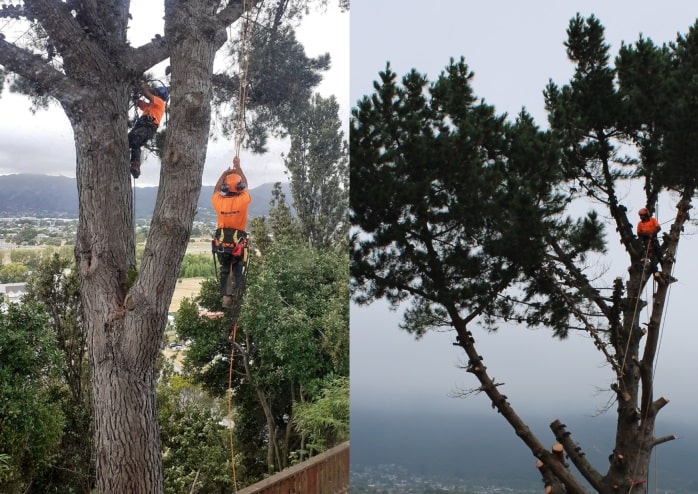Life Up a Tree in Wellington: Tales from the Capital’s Canopy

Wellington is one of the most beautiful places in the country to work with trees, but it definitely keeps us on our toes. Between the steep slopes, tight urban spaces, and sprawling suburbs, it’s a city that demands a good head for heights, a knack for problem-solving, and a healthy sense of humour for a life up a tree in Wellington.
The Hills Have Trees
Let’s start with the obvious: Wellington is hilly. Really hilly. You don’t so much walk around here as climb. That’s fine if you’re out for a jog, but when you’re carrying a 30kg harness, 50 metres of rope, and a chainsaw, it becomes more of a stair-master workout with built-in risk assessment.
Many of the trees we’re called to work on are growing on steep banks, above houses, or tucked away on narrow tracks where no truck or machine could possibly follow. That means a lot of climbing, rigging, and careful manoeuvring, often while trying not to fall into someone’s garden or bounce a branch off the neighbour’s roof.
Add a classic Wellington southerly to the mix, and you’ve got yourself an airborne adventure. We’ve been known to delay jobs just because the wind is too unpredictable. It’s not worth risking safety, or explaining to a homeowner why their fence now has a tree-shaped hole.
The Urban Jungle
Wellington’s urban areas are just as tricky, only instead of wild slopes, we’re working in tight backyards, alongside power lines, and within earshot of three barking dogs and a curious toddler pressing their face to the window.
Street access? Rare. Parking? Ha! If we get closer than 100 metres to the job site, we consider it a win.
Working around houses means we need to be surgical. Trees are often growing inches away from homes, decks, or even washing lines. A poorly aimed branch drop can take out a barbecue or, worse, Gran’s prized camellia. So we plan every cut with military precision (and maybe send a quick plea to Tāne Mahuta for good measure).
Trees Across the Capital
Wellington’s suburbs are wonderfully diverse, each with its own quirks. In Eastbourne, we’re often trimming back windswept pines or tidying coastal pōhutukawa. In Karori, it’s damp and leafy, and we’re dealing with height reductions and decay-prone species. In the Hutt Valley, trees often grow bigger and faster, and out in Tawa or Johnsonville, you get a mix of shelterbelt management and fast-growing exotics.
Knowing what thrives where, and what doesn’t, is part of the job. We often advise homeowners on what to plant (or not plant), when to prune, and how to keep large trees safe and healthy in their specific microclimate. A tree that’s perfect for one Wellington suburb could be completely wrong for another.
It’s Not Just About Chainsaws
At the heart of it, being an arborist isn’t just about cutting things down, it’s about helping trees coexist with people, homes, and the weather. We remove dangerous limbs before they come down in a storm, open-up views while protecting a tree’s shape, and help trees live longer, healthier lives through thoughtful care.
And yes, sometimes we do need to take a tree out, but we always aim to do it responsibly, safely, and with the least disruption to your garden and your neighbours.
In Conclusion (Before the Wind Picks Up Again)
If you live in Wellington and have trees on your property, you’ve got a beautiful asset, but also a bit of responsibility. Whether it’s managing height, restoring views, or just keeping things safe, regular tree care goes a long way.
So if you see someone halfway up a gum tree, carefully lowering a branch with ropes while yelling over the wind, it’s probably one of us. Give us a wave, but maybe don’t start a conversation unless you want a full rundown on pruning angles.
